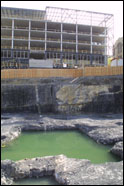New home for genomes
Dr. Tom Hudson is finally getting his building. After four years of campaigning and fundraising among the provincial and federal governments, the founding director of the Montreal Genome Centre has obtained the necessary grants to build a new research space where investigators will map out how our bodies function.
 PHOTO: Owen Egan
PHOTO: Owen Egan |
|
Fifty scientists from the Montreal Genome Centre will say farewell to seven scattered labs across the McGill University Health Centre and finally unite in one central facility: The Montreal Genomics and Proteomics Centre and Jamson T.N. Wong Laboratories for Bone and Periodontal Research (MGPC).
The building with the incredibly long name, which is scheduled for completion in fall 2002, is being billed as Canada's newest research address and will remain an integral part of the McGill University Health Centre. Soon to rise between Dr. Penfield Ave. and University St., the quarters are being built on the site of the former Donner Building, a dysfunctional space that was demolished last summer to accommodate the new project.
The six-storey structure will be constructed at a cost of $31.6 million to help meet the critical demand for modern and cross-disciplinary research space. "The strength of this new building is how it will enable researchers to work in clusters, side by side," says Hudson, who's internationally renowned for his pioneering work in genomics and the dissection of complex genetic diseases.
The four other groups that will share the MGPC's 100,000 square feet of space include: the Montreal Proteomics Centre (directed by John Bergeron, chair of the Department of Anatomy and Cell Biology), the Génome Québec Expertise Centre, the Montreal Centre for Bone and Periodontal Research (directed by David Goltzman and associate director Janet Henderson), as well as a bio-business incubator.
Hudson compares the new facility to an exploratory vessel, the first in Canada to combine both genomics and proteomics research, where research investigators will join forces to further sequence human genomes and pinpoint how their proteins interact. "We will launch many expeditions to discover the mysteries that lie within," he says. "Investigators will share one mission: to examine the mass interaction between genes and proteins."
This feat will require the combined expertise of molecular biologists, geneticists, mathematicians and computer scientists. "By juxtaposing expertise, we'll be able to look at the bigger picture," says Hudson. "We need to see how all the different parts work together."
Graduate students will also be recruited to work within the new premises. "We promise to challenge their minds to understand biology in all its dimensions," says Hudson, who also doubles as a professor in the departments of human genetics and medicine.
Construction of the MGPC has become a reality, thanks to the support of the following organizations: Canada Economic Development; Génome Québec; Genome Canada; the Ministère de la technologie, de la science et de la recherche du Québec; the Canada Foundation for Innovation; the Donner Canadian Foundation; Mrs. Pierrette Wong, in memory of the late Jamson T.N. Wong; Valorisation-Recherche Québec; McGill and the MUHC.
Over the next five years, the above partners will together contribute $100 million for the construction of the MGPC, its operations and equipment. Funding for technology will be particularly important, since a gene-sequencing machine can retail for up to $500,000.
Abraham Fuks, dean of McGill's Faculty of Medicine, is grateful the MGPC will provide Canadian researchers with access to the latest equipment and the most modern of labs. "The race is on to conduct studies of genes and chromosomes using information technology and robotics," he says. "We're extremely grateful to our valued partners. Because of their shared vision, Canadian researchers will be offered the facilities and equipment they need to remain at the forefront of the genomics and proteomics research race."
James Lund, dean of McGill's Faculty of Dentistry, looks forward to the promise of genomics and proteomics researchers sharing quarters with investigators from the Montreal Centre for Bone and Periodontal Research. The latter group will include four subdivisions: one for histology, imaging and biomechanics; a cell and tissue bank; a transgenic mouse facility; and a molecular biology division.
"Cross-disciplinary research is the key to future discoveries," says Lund. "This new building will allow us to increase collaboration to unprecedented levels."
Emil Skamene, scientific director of the Research Institute of the MUHC, says the multidisciplinary structure will change Canadian science and transform Quebec into one of the top 10 genomics and proteomics research centres in the world. "Boosting genomics research capacity is essential," Skamene says. "Genomics research is revolutionizing medicine and will greatly improve scientific approaches to disease diagnosis, treatment and human health."
An important feature of the MGPC will be its bio-business incubators that will occupy two floors of the building. The incubators will be rented workspace for start-up genomic-based companies wishing to be linked with an academic environment. The mingling of academics and small business may eventually create partnerships between both parties, not to mention providing a source of revenue for the MGPC.
Another significant component of the MGPC will be its recruiting appeal. Between 120 and 200 researchers will eventually be housed in the building. "It will be an extraordinary magnet," says McGill Principal Bernard Shapiro.
Provost Luc Vinet agrees. "We're in a global competition for the best scientific minds," says Dr. Vinet. "Having the MGPC built will give all Montreal universities an edge in hiring top scientists from around the world who'll be eager for an opportunity to work here."
The MGPC will be an integral part of McGill's TechSquare -- a North American research hub integrating information, materials and health sciences -- comprising the Wong Material Sciences Building, the Strathcona Anatomy and Dentistry Building, the Lorne. M. Trottier Information Technology Building and the Rutherford Physics Building.
"(The MGPC) will become embedded within the fabric of Quebec science," says Hudson. "These facilities will prevent us from being second in line. We want to be innovators and the first in Canada."

